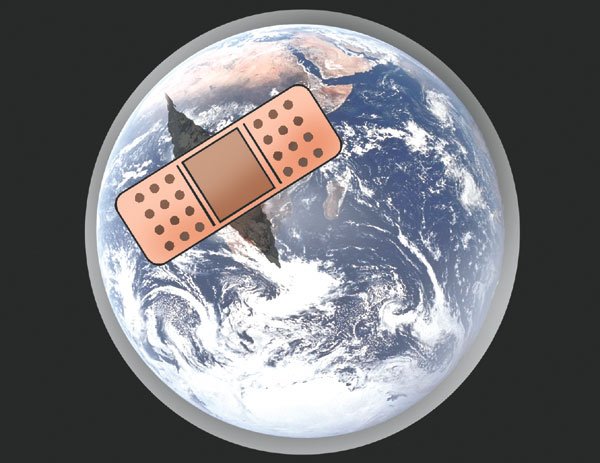Scientists are predicting it will take 20 years longer than
expected for the enormous hole in the ozone layer to close, which
means more harmful ultraviolet rays will enter the atmosphere
More than 10 years ago, Aromas resident Lisa Danes sat in her junior high school science class and learned there was a hole in the ozone layer over Antarctica.
“I remember our teacher telling us that aerosol hair spray contributed to the depletion of the ozone, and for some reason it’s always stuck with me,” she said. “I’ve never used (aerosol hair spray) since.”
Danes is one of the millions of Americans trying to do little things to help reduce the size of the hole in the ozone layer, which protects the earth from the sun’s dangerous rays. But scientists say it’s going to take much more time than they anticipated to repair the hole, which is the size of North America, and most of the damage has already been done.
Until the hole closes, the earth will be exposed to increased levels of ultraviolet radiation, which can lead to an overexposure of the rays and cause a number of health problems in humans.
“The idea of not using hair spray today because of the CFC (chlorofluocarbons) content is no longer applicable,” said Eric Kuwada, an environmental science teacher at Gilroy High School.
Chlorofluocarbons are chemical particles that have been linked to the destruction of the ozone layer, and in 1987 the Montreal Protocol banned any more development of these chemicals in developed nations. Because of this ban, scientists predicted the hole would be closed by 2040 but recently announced it could be as long as 2065.
According to Dale Hurst, an atmospheric chemist from the National Oceanic and Atmospheric Administration, the majority of the dangerous emissions are most likely coming from leftover fire extinguishers, refrigerators and air-conditioning systems that are legally being recycled and are slowly leaking into the atmosphere. Kuwada added that Third World countries are still using CFCs, which is adding to the problem.
CFCs used to be widely used as refrigerants, insulating foams and solvents. Strong winds carry CFCs into the stratosphere in a process that can take as long as two to five years. When CFCs break down in the stratosphere, they release chlorine, which attacks ozone.
Each chlorine atom acts as a catalyst, repeatedly combining with and breaking apart as many as 100,000 ozone molecules during its stratospheric life. Other ozone-depleting substances include pesticides such as methyl bromide, halons used in fire extinguishers, and methyl chloroform used in industrial processes.
“The life span of these halogens in the atmosphere is said to be in the 100-year range, thus the gloomy forecast for the ‘hole’ to repair itself,” Kuwada said.
Sam Laage, an ecology professor at Gavilan College, agrees.
“Some of those chemicals have a very long hang time, and it will simply take a while before they fall back to earth,” he said.
Keeping the ozone layer intact is crucial to the well-being of all life forms on the plant. The layer, which sits 20 miles above earth, protects humans, plant life and animals from ultraviolet rays that can cause cancer and cataracts. They also can harm wildlife.
“The process of making ozone is a natural process, occurring all the time. However, with these halogens lasting years in the stratosphere, the process is stymied and can’t keep up with the destruction,” Kuwada said.
Protect Yourself from Ultraviolet Radiation
Limit Time in the Midday Sun
The sun’s rays are strongest between 10am and 4pm. Whenever possible, limit exposure to the sun during these hours.
Seek Shade
Shade is a good source of protection, but keep in mind that shade structures – such as trees, umbrellas and canopies – do not offer complete sun protection. Remember the shadow rule: If you can’t see your shadow, seek shade.
Wear a Hat
A hat with a wide brim offers good sun protection to your eyes, ears, face and the back of your neck. These areas are particularly prone to overexposure to the sun.
Cover Up
Wearing tightly woven, loose-fitting and full-length clothing is a good way to protect your skin from the sun’s ultraviolet rays.
Sunglasses
Sunglasses that provide 99 to 100 percent UVA and UVB protection will greatly reduce sun exposure that can lead to cataracts and other eye damage. Check the label when buying sunglasses.
Always Use Sunscreen
Apply a broad spectrum sunscreen with a sun protection factor (SPF) of at least 15 or higher liberally on exposed skin. Reapply every two hours or after working, swimming, playing or exercising outdoors. Even waterproof sunscreen can come off when you towel off, sweat or spend extended periods of time in the water.
Avoid Sunlamps and Tanning Parlors
The light source from sunbeds and sunlamps damages the skin and unprotected eyes. It’s a good idea to avoid artificial sources of ultraviolet light.
Watch for the UV Index
The UV Index provides important information to help you plan your outdoor activities in ways that prevent overexposure to the sun. Developed by the National Weather Service the United States Environmental Protection Agency, the UV Index is issued daily in selected cities across the United States.
-The United States Environmental Protection Agency














